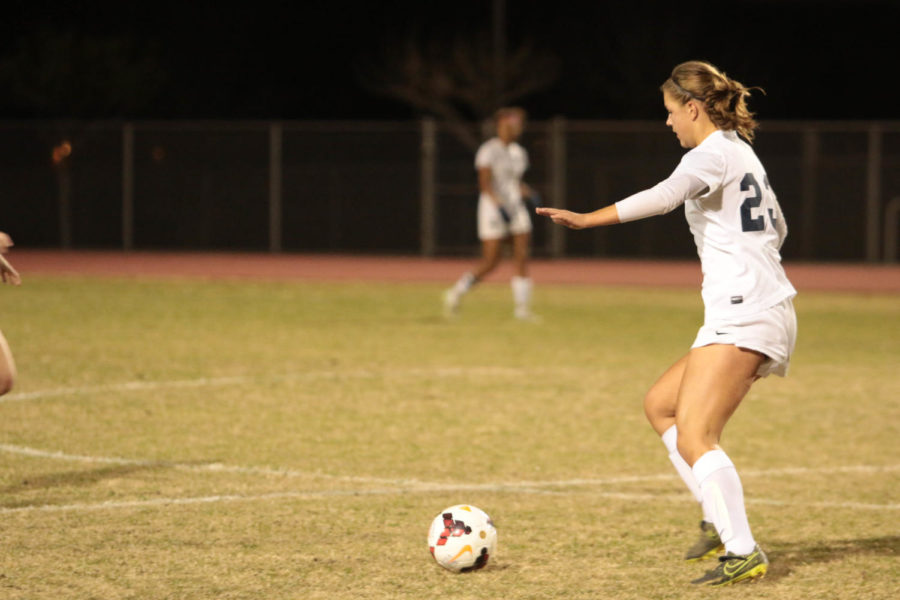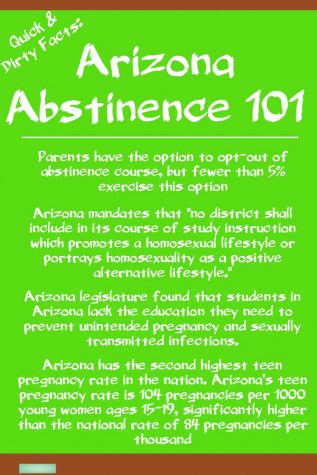Defender Emma Richey (12) moves in for a goal against Campo Verde in a successful 6-0 game.
Complicated $15 billion youth sports industry and high school athletics trying to co-exist
The battle between club and high school
High school sports play a crucial role in a school’s culture, unifying students and faculty with team spirit. We saw this recently with the badminton, volleyball, and football teams in their runs for a state championship, culminating in a buzz on campus that PHS had never seen before.
Administrators, coaches, and athletes agree that as exciting as this fall’s seasons were for so many on campus, high school sports are being threatened by something that they may not be able to combat.
Today’s student-athlete has many pressures on their shoulders — including securing an athletic scholarship — and they know in today’s competitive world of college recruiting, the best way to be seen is not in a cardinal and navy uniform, but rather in a club jersey.
“I’ve been around high school sports for 33 years and rarely do I see a college coach come to a high school game to watch a kid play, unless they really want them,” Principal Dan Serrano said, attesting to the inability to be seen by colleges when focusing on high school sports alone.
As club sports become more prevalent in America — youth sports is a $15.3 billion industry — high school sports are noticing an increase in athlete burn-out, injuries, or worse, student-athletes giving up their high school careers altogether.
Athletes are torn — school pride or individual acknowledgement?
According to a May 2017 survey of 21,233 college athletes by the National Collegiate Athletic Association (NCAA), 95 percent of women and 93 percent of men playing collegiate soccer reported that they played on a club team.
College scouts simply do not recruit student-athletes at high school games, opting instead for showcase club events when the pool is greater and they have the ability to scout more than one specific athlete.
Club is not the only route, though, as many student-athletes choose to do both, getting the club exposure that will take them to college, as well as the practice and experience of high school sports. The aforementioned survey emphasized this, with more than 95 percent of the surveyed athletes reporting that they also played on a high school team. When club and school ball coincide, though, it can leave student-athletes exhausted and at higher risk for injury.
“November is pretty crazy,” soccer player and United States Military Academy commit Emma Richey said, noting the month in which the two overlap. “It usually works out where we finish school for the day and then we go to club practice. It’s a lot of soreness, a lot of ice baths, a lot of stretching and recovering.”
Are club sports taking away multisport athletes?
Rewind the clock 20 years and a one-sport student-athlete was rare. Most athletes played two, if not three sports.
Now in an era of early specialization, that is not the case.
“I get concerned with club because it has taken over a little bit of high school kids’ ability to do more than one sport,” said Serrano. “If you look at the rosters of our baseball team, how many football players play baseball or basketball? Hardly any.”
Although students who diversify themselves and their skills through various sports may stand out to college coaches, the dynamic of high school and club programs makes it nearly impossible to commit to anything other than the practice, time, and expense for one.
According to a chart published by the NCAA, less than eight percent of high school women’s soccer players play collegiately, with just over two percent playing at a Division I school. For men, less than six percent go on to a NCAA team, with less than two percent playing Division I soccer. Scholarships are nearly impossible to come by, making it all the more difficult for high school players to turn down the opportunity club gives them to be in the one percent.
“I don’t think club sports are going to go away because that’s how kids get scholarships,” Serrano said, noting that student-athletes focus on the sport that they believe will get them onto a college roster.
The bark is worse than the bite
Despite the inescapable time commitment and risk of injury in either club or high school, the conflict between the two sides of youth sports may not be as divisive as one thinks.
“Our coaches on either side are really understanding and they are pretty lenient and our teachers are understanding, too,” Richey said. “They give us time to catch up.”
As for choosing one over the other, the statistics just do not lie about the importance of being involved in a sport in as many ways as possible.
“A couple of my good friends have chosen to stick just to club to keep working with it, but for the most part all of us have kept with both of them at the same time,” Richey said. “I think high school soccer is just kind of a camaraderie thing, everyone together just representing your school, but I think it’s important.”
For Serrano, as well as athletic directors and high school coaches around the country, club sports are something to familiarize themselves with, as student-athletes simply cannot afford to leave the club world.
Macie Miller contributed to this story.
Young adults deserve more than scare tactics in sex education
Sophomores have been told “keep your pants on for safety,” in Comprehensive Health for years. This single phrase implies that once your pants are removed, you’ll be in some sort of life-threatening danger — and scare tactics like these contribute to why teen pregnancy and rape cases are higher in America than anywhere else.
According to the U.S. Department of Health and Human Services, Arizona was ranked 15th highest in the nation for final teen births rates among females aged 15-19 in 2011.
Using scare tactics to keep youth abstinent is the most outdated form of sexual education any program could utilize. Scaring young adults to think that sexual intercourse is the most obscene act that any two people could do together creates a negative stigma around a mutually sensual and not-at-all dangerous activity. Not only does this create a divide between adults and adolescents (because youth feel as if sex is an “inappropriate topic” that should not be discussed) but many go their entire high school careers oblivious to proper contraceptive use or STDs due to this.
The Guttmacher Institute, a non-profit organization committed to advancing sexual and reproductive health, states that “about one in four adolescents aged 15-19 (23% of females and 28% of males) received abstinence education without receiving any instruction about birth control in 2006–2008, compared with 8–9% in 1995.”
This is the problem a substantial amount of unplanned teen pregnancies stem from — inadequate knowledge regarding contraceptives. Teens are not learning the real information that should be commonplace among all adults; most teens do not even feel comfortable asking their parents or close family members about sex, so they need to get the real facts from somewhere other than Google.
Unfortunately, young adults are being desensitized to rape and sexual abuse through the media, music, movies, and the internet. Schools are not addressing these sources and setting teens straight, which is sending mixed messages. These discrepancies greatly attribute to the growing rape culture in America.
The Maine Coalition Against Sexual Assault states that one in five women has been the victim of attempted or completed rape in their lifetime, and nearly 1 in 2 women have experienced sexual violence other than rape in their lifetime. These numbers are too high; yet, instead of teaching young men that no one is asking for sex unless it is explicitly stated, young women are taught to never show their shoulders in school for it might turn someone on, or to never put down their cup at a party unless they want to be roofied, or to not walk the streets without pepper spray.
Schools need to be teaching that students should be comfortable and confident in their bodies.
Schools need to be teaching that it is normal and acceptable to be a sexually active teen, and that contraceptives are a must for those who choose not to be abstinent.
Schools need to be teaching that young women are not prostitutes for showing a little skin, and that sexually active teens are not any less of a person for lacking their “v-card.”
Schools should be teaching adolescents every topic of sex, not preaching abstinence, because sex happens.




